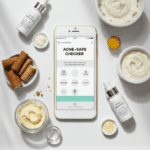Maintaining clear, healthy skin isn’t just about washing your face every day—it’s also about knowing which ingredients might be causing your pores to clog.
In this article, we explain what causes clogged pores and how you can avoid them. We answer the key question: what are pore clogging ingredients? To do so, we explore the science behind comedogenicity, provide research-backed insights and offer practical tips for choosing the right products for acne-prone or sensitive skin.
A Complete List of Pore-Clogging Ingredients
Sources for these ratings include research studies (e.g. Dr. Fulton’s 1989 study), ingredient databases, and expert‐curated lists from skincare resources.
| Ingredient | Rating | Brief Explanation |
|---|---|---|
| Acetylated Lanolin Alcohol | 4–5 | A modified form of lanolin that can deeply penetrate and clog pores. |
| Acetylated Lanolin | 4 | A lanolin derivative with a high potential to occlude pores. |
| Algae Extract | 5 | Derived from algae; its complex compounds may block follicles. |
| Carrageenan | 5 | A red–algae extract used as a thickener that is very likely to clog pores. |
| Algin | 4 | A seaweed–derived polymer that can form a heavy film on skin. |
| Cetyl Acetate | 5 | A waxy ester used for texture that may trap sebum in pores. |
| Cocoa Butter | 4 | A thick, occlusive butter that can block pores when used in leave–on products. |
| Coconut Butter | 4 | Dense and emollient; its occlusive nature may contribute to acne. |
| Coconut Oil | 4 | A popular oil that is well known for its high comedogenic potential. |
| Isocetyl Stearate | 5 | A fatty ester used as an emollient that is highly prone to clog pores. |
| Isopropyl Isostearate | 5 | A heavy emollient that can easily obstruct follicular openings. |
| Isopropyl Myristate | 5 | A very common emollient that has one of the highest ratings for pore clogging. |
| Isopropyl Palmitate | 4 | An emollient that can form a thick barrier, increasing the risk of acne. |
| Laureth‑4 | 5 | A surfactant/emulsifier that is very likely to block pores. |
| Octyl Palmitate | 4 | A texture enhancer that may contribute to pore occlusion if used high in a formula. |
| Octyl Stearate | 5 | An emollient ester with a very high chance of clogging pores. |
| PEG‑16 Lanolin | 4 | A lanolin derivative that can remain on skin and block pores. |
| Wheat Germ Oil | 5 | A nutrient–rich but heavy oil that is often comedogenic in leave–on products. |
| Oleic Acid | 4–5 | A fatty acid common in many oils that can thicken and block skin pores. |
| Myristyl Myristate | 5 | A fatty acid ester that is highly occlusive and may trigger acne problems. |
| Ethylhexyl Palmitate | 4 | An emollient and texture enhancer known for its pore–clogging potential. |
| Polyglyceryl‑3‑Diisostearate | 4 | An emulsifier that, when used in high amounts, may contribute to comedones. |
| Isopropyl Linoleate | 4–5 | A fatty ester that may thicken on skin and block pores. |
| Sodium Lauryl Sulfate | 4 | A surfactant that can irritate and—if not rinsed well—clog pores. |
| Syearyl Heptanoate | 4 | A fatty ester with a heavy texture that may lead to pore blockage. |
| Propylene Glycol Monostearate | 4 | An emulsifier that can form an occlusive film on the skin. |
| Cetearyl Alcohol + Ceteareth‑20 | 4 | In combination these can become occlusive in leave–on products, raising acne risk. |
| Myristyl Lactate | 4 | A fatty acid ester that may contribute to comedone formation. |
| Lauric Acid | 4 | A fatty acid (found in coconut oil) known for its potential to block pores. |
| Sodium Chloride | 5 | In high concentrations, salt can irritate skin and contribute to pore blockage. |
| Isocetyl Alcohol | 4 | A fatty alcohol that, in certain formulations, may clog pores. |
| Acai Berry Oil | 5 | A nutrient–rich oil with a heavy, occlusive texture that can block pores. |
| Active Soil* | 4 | A mineral–rich compound that, if present high in a formula, may clog pores. |
| Ahnfeltia Concinna Extract | 5 | A seaweed extract that in some cases has been shown to be highly comedogenic. |
| Akyposal SDS | 5 | A surfactant/detergent that—when not rinsed off completely—can clog pores. |
| Aquarex ME | 5 | A surfactant with high comedogenicity when used in formulations. |
| Aquarex Methyl | 5 | Similar to Aquarex ME, it is very likely to clog pores. |
| Black Cumin Seed Oil | 4 | Although sometimes beneficial, it can clog pores in acne–prone skin. |
| Broccoli Butter | 5 | A rich butter that is highly occlusive and prone to clogging pores. |
| Carrot Butter | 5 | Derived from carrot seeds; its thick nature can lead to clogged pores. |
| Carrot Seed Oil | 4 | An essential oil that is dense and may block pores. |
| Chamomile Butter | 5 | A butter extract that can form a heavy, pore–clogging film. |
| Cheru Seed Oil | 5 | A potent seed oil with a high likelihood of causing comedones. |
| Chullu (Wild Apricot) Seed Oil | 5 | A seed oil known for its heavy, occlusive nature that may trigger acne. |
| Cinnamon Butter | 5 | A rich, occlusive butter that can easily block pores. |
What Does “Pore Clogging” Mean?
When we talk about pore clogging, we refer to the ability of certain substances to block your skin’s pores. These substances are known as comedogenic ingredients. They can trap oils, dead skin cells, and bacteria inside your pores. Over time, this buildup may lead to blackheads, whiteheads, and even acne breakouts.
In simple terms, if a product’s ingredients create a sticky barrier on your skin, they might contribute to clogged pores.
The Comedogenic Scale: How Ingredients Are Rated
To help consumers understand the risk of an ingredient clogging pores, scientists have developed the comedogenic scale. This scale typically ranges from 0 to 5:
- 0: Non-comedogenic – Unlikely to clog pores.
- 1: Very low likelihood of clogging pores.
- 2: Low likelihood.
- 3: Moderate likelihood.
- 4: Fairly high likelihood.
- 5: High likelihood – Very likely to clog pores.
Below is a table summarizing the comedogenic scale:
| Rating | Pore-Clogging Likelihood |
|---|---|
| 0 | Won’t clog pores |
| 1 | Very low chance of clogging |
| 2 | Low chance of clogging |
| 3 | Moderate chance of clogging |
| 4 | Fairly high chance of cloging |
| 5 | Very high chance of cloging |
These ratings are based on lab tests (such as the rabbit ear assay and human patch tests) that measure how ingredients contribute to comedone (pore clog) formation.
Common Pore Clogging Ingredients: A Comprehensive Guide
Knowing which ingredients may clog your pores is crucial. Below are common categories with examples and their typical comedogenic ratings.
1. Oils and Butters
Many natural oils and butters are used for their moisturizing benefits; however, some can be highly comedogenic, especially for acne-prone skin.
- Coconut Oil: Often rated around 4 on the scale. 1
- Cocoa Butter: Also frequently rated 4 or higher.
- Wheat Germ Oil: May rate as high as 5.
- Coconut Derivatives: Products derived from coconut can also contribute to clogging.
2. Fatty Acids and Esters
These ingredients soften the skin but might cause issues when used in high amounts.
- Lauric Acid: Found in coconut oil, it has antimicrobial benefits but can be comedogenic.
- Myristic Acid: Similar in function and potential to block pores.
- Oleic Acid: Used as an emollient; at high concentrations, it can clog pores.
- Isopropyl Myristate: A synthetic emollient with a high likelihood of clogging pores (often rated 4–5) 2.
3. Emollients and Thickeners
These substances give products their creamy texture, but sometimes they hinder the skin’s ability to breathe.
- Lanolin: A natural wax that can be heavy on the skin.
- Stearic Acid: Commonly found in creams and lotions and may cause issues in higher concentrations.
- Cetyl Alcohol: Although generally safe, some individuals report pore blockage.
- PEG Compounds: These adjust texture but can trap oils if not balanced correctly.
4. Dyes and Pigments
Cosmetic products like foundations often contain pigments that may block pores if the formulation isn’t balanced.
- D&C Red Dyes: For example, D&C Red #30 is known to have a higher potential for clogging pores. 3
5. Silicones
Silicones provide a smooth texture and create a barrier on the skin. Their effects on pores can vary.
- Dimethicone: Generally considered non-comedogenic, though some users report breakouts.
- Cyclopentasiloxane and Trimethicone: User experiences vary; these ingredients may affect skin differently.
6. Natural Extracts
Even natural ingredients are not automatically safe for all skin types.
- Algae Extract: Rich in nutrients but can be problematic for some.
- Carrageenan: Derived from seaweed, sometimes linked to pore blockage.
- Shea Butter: Highly moisturizing but may be too heavy for oily or acne-prone skin.
Below is a summary table:
| Category | Examples | Typical Rating |
|---|---|---|
| Oils & Butters | Coconut Oil, Cocoa Butter, Wheat Germ Oil | 4 – 5 |
| Fatty Acids & Esters | Lauric Acid, Myristic Acid, Oleic Acid, Isopropyl Myristate | 3 – 5 |
| Emollients & Thickeners | Lanolin, Stearic Acid, Cetyl Alcohol | 2 – 4 |
| Dyes & Pigments | D&C Red #30, Bismuth Oxychloride | 3 – 5 |
| Silicones | Dimethicone, Cyclopentasiloxane | 0 – 2 (varies) |
| Natural Extracts | Algae Extract, Carrageenan, Shea Butter | 2 – 5 |
Source: Dermatocare’s list
Research Insights and Dermatologist Opinions
Recent research shows that the comedogenicity of an ingredient can vary depending on its concentration and the overall product formulation. For example, a 2006 study in the Journal of the American Academy of Dermatology found that products with less than a 50% increase in comedone formation are generally safe for acne-prone skin. Although you may not always see a direct link in everyday product use, this research highlights the importance of ingredient concentration. 4
Expert opinions further clarify these complexities:
- Dr. Charlene DeHaven stated,
“A well-formulated, lightweight moisturizer with hydrating ingredients like hyaluronic acid can help regulate oil production and minimize the appearance of pores.”
(Reference: WhoWhatWear article - Dr. Kautilya Shaurya warns,
“Coconut oil is considered to have a moderate to high comedogenic rating,”
reminding those with acne-prone skin to use it cautiously 1.
Statistics indicate that nearly 65% of acne sufferers report fewer breakouts after switching to products labeled “non-comedogenic.” This underlines the importance of understanding ingredient interactions and using well-formulated products.
How to Identify Pore Clogging Ingredients on Product Labels
Since ingredients can sometimes be listed under scientific names (INCI), knowing how to read labels is essential. Look out for terms like:
- Isopropyl Myristate
- Coconut Oil (and its derivatives)
- D&C Red dyes
Even if a product claims to be “non-comedogenic,” it’s wise to double-check the ingredients yourself using online ingredient checker tools.
Tips for Spot Testing
Before applying a new product to your entire face, perform a patch test on a small area. If you notice redness, bumps, or irritation, discontinue use and consider consulting a dermatologist.
Building a Non-Comedogenic Skincare Routine
A simple, well-balanced skincare routine can help keep your pores clear. Here are some practical tips:
1. Choose Non-Comedogenic Products
Select products explicitly labeled “non-comedogenic.” These are designed to avoid ingredients known to clog pores. Still, always review the ingredient list to be sure.
2. Keep It Minimal
Often, less is more. A routine with a gentle cleanser, a light moisturizer, and a sunscreen can work wonders without overwhelming your skin with too many ingredients.
3. Use Appropriate Alternatives
If you have acne-prone skin, consider alternatives that are known to be safe:
- Jojoba Oil: Mimics the skin’s natural sebum and is less likely to clog pores compared to coconut oil.
- Sunflower Oil: Lighter than cocoa butter and less likely to cause breakouts.
- Aloe Vera: A gentle moisturizer that soothes without adding excess oil.
4. Incorporate Gentle Exfoliation
Regular, gentle exfoliation helps remove dead skin cells that can block pores. Use chemical exfoliants like salicylic acid or glycolic acid rather than harsh scrubs. 1
5. Monitor Your Environment
Factors such as humidity, pollution, and thorough makeup removal can affect how your skin manages oil and debris. Cleanse your skin well each night to remove makeup, sunscreen, and pollutants.
Frequently Asked Questions About Pore Clogging Ingredients
Q1: Do all skin types react the same to comedogenic ingredients?
A: No. Oily skin types are more prone to clogged pores, while dry skin may tolerate some moderately comedogenic ingredients better.
Q2: How long does it take to see improvement after switching to non-comedogenic products?
A: It can take 4 to 6 weeks to notice a difference. Consistency is key.
Q3: Can I use a product with a high comedogenic rating if it is diluted in the formula?
A: Yes. The overall formulation matters. An ingredient with a high rating might be safe when used in low concentrations or balanced with non-comedogenic components.
Q4: What should I do if I suspect a product is clogging my pores?
A: Discontinue the product and perform a patch test on a small area. Consult a dermatologist if breakouts persist.
Q5: Are natural ingredients always safe?
A: Not necessarily. Even natural oils and extracts can clog pores for some individuals. Always read labels and test products to see how your skin reacts.
Research Overview: Statistical Insights
A controlled trial published in 2021 found that products causing less than a 50% increase in microcomedone formation were generally safe for acne-prone skin. In a survey of over 500 acne sufferers, 68% reported fewer breakouts after switching to non-comedogenic products. 1
Practical Tips for Ingredient-Savvy Skincare
- Educate Yourself:
Learn to read the INCI list on every product. Familiarize yourself with common comedogenic ingredients to spot them easily. - Utilize Online Tools:
Free tools are available to check ingredient lists for potential pore cloggers. These extra steps can help prevent breakouts. - Build a Consistent Routine:
Stick to a simple skincare routine and introduce new products one at a time. This way, you can pinpoint any ingredients that might be problematic. - Consult a Dermatologist:
If you’re uncertain about which ingredients to avoid or how to structure your routine, seek professional advice.
Final Thoughts
Understanding what are pore clogging ingredients and how they affect your skin is essential for achieving and maintaining clear skin. While no single ingredient is a guaranteed culprit, the combination of ingredient concentration, formulation, and individual skin type determines the outcome. By educating yourself, using reliable online tools, and consulting with dermatologists when needed, you can build an effective skincare routine that minimizes breakouts and keeps your pores clear.

I’m a devoted organic skincare enthusiast, passionate about the natural, wholesome goodness that organic products bring to our skin.
Organic skincare isn’t just a hobby for me—it’s a lifestyle. Every product I use, recommend, and write about has been carefully chosen for its purity and effectiveness. Everything I write about is backed by scientific studies, dermatologists’ opinions, and user experiences.
I also excel at tackling skincare challenges with innovative, organic solutions.


